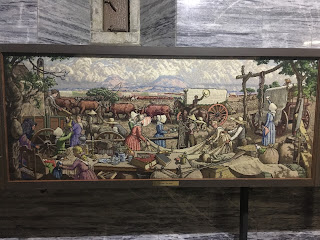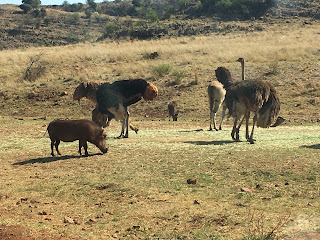I wrote this post at least 4 years ago, but never posted it for some reason. I stumbled on it today and thought it deserved sharing.
---------------------------------------------------------------
My brother was teaching the priesthood lesson this week from the Pres. George Albert Smith manual. It was the third or so in a row in being member missionaries. I forget the exact words Steve used, but he and the lesson talk about the fact that you cannot "scold" anyone into Heaven, "but I want to tell you that we can love them into the direction of our Father in heaven..."
When Steve quoted the second great commandment, to love our neighbors as ourselves, it got me thinking. The command is NOT to convert a bunch of people, and therefore love them because it's a useful tactic. The command is to love them, and as a happy result of that you will occasionally get the chance to be of service to them.
--------
We had a few too many visits from a friendly, agreeable, thoughtful plumber this summer. When his work was done, I asked if he had ever been given the opportunity to have a Book of Mormon. He confirmed that he had several LDS friends and he knew it was required in many churches to try to win converts. I wasn't sure how to respond. He didn't sound offended, but I could tell the gesture was not received the way I felt.
He was a nice guy. He had made our lives better working harder than was strictly required. I wanted to thank him with more than money. I wanted to form a friendship in the little time we have in the States, and quite frankly the Church is the primary way I socialize.
He was one of many people whose lives I would like to bless with the thing that has given me the greatest joy. The thing is, most of those people I'm going to see again, so I can comfortably keep putting off that invitation - mostly in the fear that it and I will be rejected and taken in one of many wrong ways. But I cared for someone and wanted to share.
--------
Before we moved to Nigeria, I was an assistant clerk keeping track of membership records and then executive secretary. Among the things I did was track attendance. I didn't feel that was enough. I wanted to know if someone was missing. I not only counted heads, but learned to recognize everyone by the back of their head so I could tell if someone was missing for a few weeks and make sure the proper people had noticed and were taking care of them.
When new people moved in - a frequent occurrence in student areas - I ran over to greet them. This was a very new phenomenon for me. I'd always been content (as music chair or choir director) to find out if someone had musical talents and rush over once someone told me they sang. Now it was my job to get the information of new members so I could request their records into the area. But more than that, I wanted them to feel welcomed and appreciated. I wanted them to stay.
Being membership clerk gave me a script to follow, and that was the support/crutch I needed to be able to get over my awkwardness and try saying hello. Home and visiting teaching is not just a duty to visit once a month, but an opportunity both to come to love and serve someone and to open our homes and hearts to someone we might not otherwise have socialized with. I'm not comfortable in a lot of social interactions, but being a home teacher, a clerk, a choir director, whoever, gives me a role to fill and helps me start reaching out.
Callings and assignments - and even missionary duties - are opportunities to get to know people, to befriend them, to learn even to love them.
They were all excuses. An excuse to love someone.
---------------------------------------------------------------
My brother was teaching the priesthood lesson this week from the Pres. George Albert Smith manual. It was the third or so in a row in being member missionaries. I forget the exact words Steve used, but he and the lesson talk about the fact that you cannot "scold" anyone into Heaven, "but I want to tell you that we can love them into the direction of our Father in heaven..."
When Steve quoted the second great commandment, to love our neighbors as ourselves, it got me thinking. The command is NOT to convert a bunch of people, and therefore love them because it's a useful tactic. The command is to love them, and as a happy result of that you will occasionally get the chance to be of service to them.
--------
We had a few too many visits from a friendly, agreeable, thoughtful plumber this summer. When his work was done, I asked if he had ever been given the opportunity to have a Book of Mormon. He confirmed that he had several LDS friends and he knew it was required in many churches to try to win converts. I wasn't sure how to respond. He didn't sound offended, but I could tell the gesture was not received the way I felt.
He was a nice guy. He had made our lives better working harder than was strictly required. I wanted to thank him with more than money. I wanted to form a friendship in the little time we have in the States, and quite frankly the Church is the primary way I socialize.
He was one of many people whose lives I would like to bless with the thing that has given me the greatest joy. The thing is, most of those people I'm going to see again, so I can comfortably keep putting off that invitation - mostly in the fear that it and I will be rejected and taken in one of many wrong ways. But I cared for someone and wanted to share.
--------
Before we moved to Nigeria, I was an assistant clerk keeping track of membership records and then executive secretary. Among the things I did was track attendance. I didn't feel that was enough. I wanted to know if someone was missing. I not only counted heads, but learned to recognize everyone by the back of their head so I could tell if someone was missing for a few weeks and make sure the proper people had noticed and were taking care of them.
When new people moved in - a frequent occurrence in student areas - I ran over to greet them. This was a very new phenomenon for me. I'd always been content (as music chair or choir director) to find out if someone had musical talents and rush over once someone told me they sang. Now it was my job to get the information of new members so I could request their records into the area. But more than that, I wanted them to feel welcomed and appreciated. I wanted them to stay.
Being membership clerk gave me a script to follow, and that was the support/crutch I needed to be able to get over my awkwardness and try saying hello. Home and visiting teaching is not just a duty to visit once a month, but an opportunity both to come to love and serve someone and to open our homes and hearts to someone we might not otherwise have socialized with. I'm not comfortable in a lot of social interactions, but being a home teacher, a clerk, a choir director, whoever, gives me a role to fill and helps me start reaching out.
Callings and assignments - and even missionary duties - are opportunities to get to know people, to befriend them, to learn even to love them.
They were all excuses. An excuse to love someone.
























































